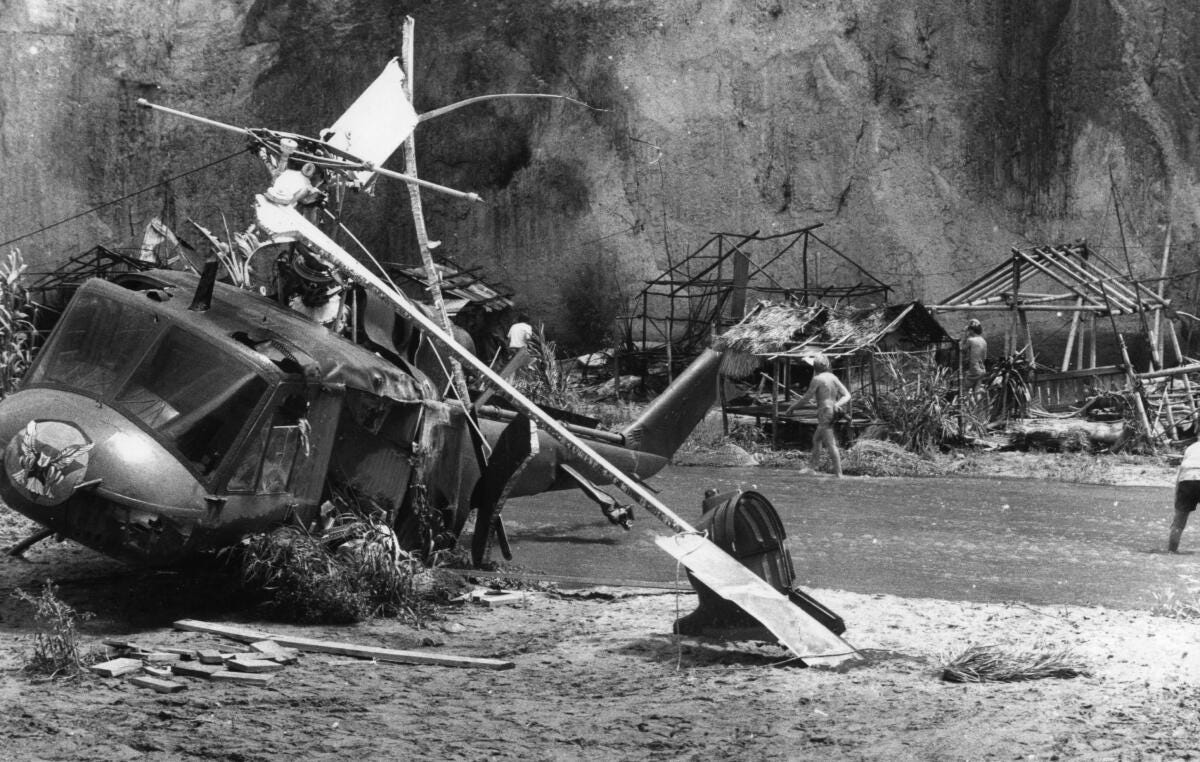On This Day in 1982: When Hollywood’s Illusion Crushed Reality
The Twilight Zone helicopter crash wasn't just a tragedy; it was a brutal reminder that ambition without accountability can kill.
On This Day, July 23rd 1982
Hollywood has always sold itself as the place where dreams come to life. But on this day in 1982, during the filming of Twilight Zone: The Movie, that illusion shattered in the most horrific way. Actor Vic Morrow and two young children, six-year-old Renee Shinn Chen and seven-year-old Myca Dinh Le, were killed when a helicopter crashed on set. It was not a freak accident. It was the deadly result of ambition unchecked, corners cut, and human life treated as expendable in service of spectacle.
You can dress it up with studio spin, legal defence, or cinematic nostalgia, but it comes down to this. Three people died to make a movie. And those responsible walked away with their careers intact. What remained was silence, splintered families, and the lingering question: why was no one held accountable?
Failure Was Not in the Skies, It Was on the Ground
Vic Morrow was a seasoned actor. He had been around enough to know the difference between performance and peril. When he stepped onto the waterlogged set that night, he was handed a scene to shoot involving low-flying helicopters, explosions, and two children he had barely rehearsed with. The shoot took place at 2am, hours past when any child should legally be working. There were no permits, no safeguards, and apparently no one willing to say “stop”.
The director had been told the stunt was dangerous. He pushed forward anyway. A mortar blast detonated too close to the aircraft. The helicopter lost control and dropped into the riverbed, killing all three in an instant. Morrow and Myca were decapitated by the rotor blades. Renee was crushed beneath the landing skid.
These were not just miscalculations. They were choices. Decisions layered one on top of the other until they collapsed into catastrophe.
No Scene Is Worth a Child’s Life
The production was built on deception. The children’s parents were misled. Crew members were told to stay quiet. Fire safety officials were kept in the dark. It was a patchwork of lies and negligence, stitched together by a belief that if you are making magic, you are untouchable.
You cannot pass off something this avoidable as bad luck. If you are waking children in the middle of the night, dragging them onto a live-action warzone, and telling their parents to pretend they are just “visiting the set,” you are already far past the line.
The aftermath was pure Hollywood damage control. The scene was deleted. The film went on. The director gave a tone-deaf speech at Morrow’s funeral. He later defended the movie’s “importance,” as if artistic intent could retroactively excuse criminal risk-taking.
The families grieved while the industry closed ranks.
Justice Deferred, Not Denied
In 1987, the director, John Landis, and three crew members stood trial for involuntary manslaughter. It should have been open and shut. But the jury delivered a verdict of not guilty. Legally, the case was closed. Morally, it left a stain no acquittal could wash out.
Hollywood did not collapse after the crash, but it flinched. Safety rules were tightened. Unions pushed for stronger oversight. But the fact that it took three deaths, including two illegally employed children, to get there is the real indictment.
Steven Spielberg, who co-produced the film, severed ties with the John Landis. He publicly condemned the “cult of the director,” where one person’s vision overrides the collective responsibility of a film crew. It was too little too late, but at least it was something. Others kept quiet, as usual.
Legacy Written in Blood
In the years that followed, the Landis carried on. He made more films. None as successful as those before this tragedy, and none as scrutinised. But his career never truly collapsed. The cost of those lives was never truly paid. Meanwhile, the families of Renee and Myca received settlements, but no justice. Money does not bring back a child. It does not erase the sound of rotor blades, or the sight of a set turned into a morgue.
Hollywood loves to mythologise itself, the risk, the grind, the creative genius. But when the myths demand real blood, they stop being stories and start becoming warnings. On July 23rd 1982, the film industry showed exactly how far it was willing to go in pursuit of a shot. The audience just was not supposed to see the bodies.
The Twilight Zone tragedy should have changed everything. In some ways, it did. But in others, it just reminded us what the system is built to protect, and what it is all too willing to sacrifice.


